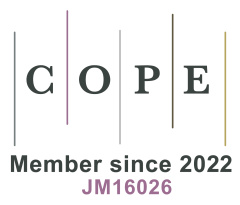Biomechanical adaptation mechanisms of temporomandibular joint movement in English pronunciation learning
Abstract
The temporomandibular joint (TMJ) plays a critical role in speech articulation, yet its biomechanical adaptation during second-language pronunciation learning remains underexplored. Non-native English speakers often exhibit excessive jaw movements and inefficient neuromuscular activation, which can impede phonetic accuracy and speech fluency. Despite advancements in phonetic training, existing methodologies lack an integrated biomechanical approach that quantitatively assesses TMJ adaptation. This study investigates the biomechanical adaptation mechanisms of TMJ movement in English pronunciation learning, focusing on jaw kinematics, neuromuscular adaptation, and phonetic precision. The research aims to quantify TMJ adaptation and its influence on speech efficiency, providing an evidence-based framework for pronunciation training. A four-week structured pronunciation training program was conducted with 72 non-native English speakers. Three biomechanical techniques were employed: Motion Capture Analysis (MCA) for jaw kinematics, Electromyography (EMG) for neuromuscular activity, and Acoustic-Phonetic Analysis for pronunciation accuracy. Additionally, Structural Equation Modeling (SEM) was applied to evaluate causal relationships between TMJ biomechanics and phonetic precision. Findings demonstrated a 39.6% reduction in jaw displacement variability, a 33.3% decrease in masseter activation, and a 35.3% improvement in syllable timing variability. While kinematic and neuromuscular adaptations correlated with enhanced phonetic precision, SEM results suggested additional mediating factors in pronunciation learning. This study provides quantitative evidence that structured pronunciation training improves TMJ biomechanics, neuromuscular efficiency, and phonetic accuracy. The findings have implications for speech training, AI-assisted pronunciation tools, and clinical speech therapy. Future research should explore long-term TMJ adaptation, tongue biomechanics, and cross-linguistic differences in speech motor learning.
References
1. Kent RD. The feel of speech: Multisystem and polymodal somatosensation in speech production. Journal of Speech, Language, and Hearing Research. 2024; 67(5): 1424-1460. doi: 10.1044/2024_JSLHR-23-00575
2. Nagamine T. Acoustic and Articulatory Dynamics in Second Language Speech Production: Japanese Speakers' Production of English Liquids [PhD thesis]. Lancaster University; 2024.
3. Valentino R, Cioffi I, Vollaro S, et al. Jaw muscle activity patterns in women with chronic TMD myalgia during standardized clenching and chewing tasks. CRANIO®. 2019; 39(2): 157-163. doi: 10.1080/08869634.2019.1589703
4. Diener L. The Impact of audible feedback on EMG-to-Speech Conversion [PhD thesis]. University of Bremen; 2021.
5. Ullah S, Kim DH. Multiaccent EMG-to-Speech Optimized Transduction With PerFL and MAML Adaptations. IEEE Transactions on Instrumentation and Measurement. 2024; 73: 1-17. doi: 10.1109/tim.2024.3449948
6. De Stefano M, Ruggiero A. A Critical Review of Human Jaw Biomechanical Modeling. Applied Sciences. 2024; 14(9): 3813. doi: 10.3390/app14093813
7. Amato F. Voice as the reservoir of valuable clinical information: a diagnosis and monitoring support for speechaffectingdiseases [PhD thesis]. Politecnico di Torino; 2024.
8. Bashori M, van Hout R, Strik H, et al. I Can Speak: improving English pronunciation through automatic speech recognition-based language learning systems. Innovation in Language Learning and Teaching. 2024; 18(5): 443-461. doi: 10.1080/17501229.2024.2315101
9. Kurbanazarova N, Shavkidinova D, Khaydarov M, et al. Development of Speech Recognition in Wireless Mobile Networks for An Intelligent Learning System in Language Education. Journal of Wireless Mobile Networks, Ubiquitous Computing, and Dependable Applications. 2024; 15(3): 298-311. doi: 10.58346/jowua.2024.i3.020
10. Egle G, Novokhrestova D, Tomilina S, Kostyuchenko E. Approach to Assessing the Quality of Syllable Pronunciation by Patients in the Process of Speech Rehabilitation Based on Comparison with Healthy Speakers. In: International Conference on Speech and Computer. Cham: Springer Nature Switzerland; 2024.
11. Utepbayeva A, Zhiyenbayeva N, Assylbekova L, Tapalova O. Artificial Intelligence Applications (Fluency SIS, Articulation Station Pro, and Apraxia Farm) in the Psycholinguistic Development of Preschool Children with Speech Disorders. International Journal of Information and Education Technology. 2024; 14(7): 927-935. doi: 10.18178/ijiet.2024.14.7.2119
12. Clukey JL. A Voice Teacher's Guide to Temporomandibular Disorders [PhD thesis]. Shenandoah University; 2022.
13. Tian L. Articulation skills of singing based on the biomechanical coordination of throat muscles. Molecular & Cellular Biomechanics. 2025; 22(1): 974. doi: 10.62617/mcb974
14. Tardelli JDC, dos Reis AC. Biomechanical, esthetic, and hygienic considerations of materials for overdenture bars: A systematic review. Dentistry Review. 2024; 4(2): 100082. doi: 10.1016/j.dentre.2024.100082
15. Stavness IK. Byte your tongue: a computational model of human mandibular-lingual biomechanics for biomedical applications [PhD thesis]. University of British Columbia; 2010.
16. Martínez-Silva B, Diéguez-Pérez M. Review on Mandibular Muscle Kinematics. Sensors. 2022; 22(15): 5769. doi: 10.3390/s22155769
17. Mohaghegh Harandi N. 3D subject-specific biomechanical modeling and simulation of the oral region and airway with application to speech production. University of British Columbia. Published online 2016. doi: 10.14288/1.0300338
18. Svensson Lundmark M, Erickson D. Segmental and syllabic articulations: A descriptive approach. Journal of Speech, Language, and Hearing Research. 2024; 67(10S): 3974-4001. doi: 10.1044/2024_JSLHR-23-00092
19. Abbass MMS, Rady D, El Moshy S, et al. The Temporomandibular Joint and the Human Body: A New Perspective on Cross Talk. Dentistry Journal. 2024; 12(11): 357. doi: 10.3390/dj12110357
20. Clukey J. Temporomandibular Disorders and the Singing Voice: A Summary of the Research. Voice and Speech Review; 2024.
21. Nainoor N, Pani G. Imaging of Temporomandibular Joint. Diagnosing and Managing Temporomandibular Joint Conditions; 2024.
22. Saito ET, Akashi PMH, de Camargo Neves Sacco I. Global Body Posture Evaluation in Patients with Temporomandibular Joint Disorder. Clinics. 2009; 64(1): 35-39. doi: 10.1590/s1807-59322009000100007
23. Ozsari S, Güzel MS, Yılmaz D, et al. A Comprehensive Review of Artificial Intelligence Based Algorithms Regarding Temporomandibular Joint Related Diseases. Diagnostics. 2023; 13(16): 2700. doi: 10.3390/diagnostics13162700
24. Perkell JS. Movement goals and feedback and feedforward control mechanisms in speech production. Journal of Neurolinguistics. 2012; 25(5): 382-407. doi: 10.1016/j.jneuroling.2010.02.011
25. Ting LH, Gick B, Kesar TM, et al. Ethnokinesiology: towards a neuromechanical understanding of cultural differences in movement. Philosophical Transactions of the Royal Society B: Biological Sciences. 2024; 379(1911). doi: 10.1098/rstb.2023.0485
26. Al Ali M. Design Temporomandibular Joint Using Nonparametric Optimization. In: Fundamentals of Orthopedic Design with Non-Parametric Optimization. Springer Nature Singapore; 2024.
27. Öksüz CE, Kalkişim ŞN, Uzun ÖK. Anatomy of the Temporomandibular Joint. In: International Studies and Evaluations in the Field of Health Sciences. Serüven Yayınevi; 2024.
28. Liu Y. Integrating Posture Control in Speech Models [PhD thesis]. University of british columbia; 2024.
29. Tsiakiri A, Plakias S, Karakitsiou G, et al. Mapping the Landscape of Biomechanics Research in Stroke Neurorehabilitation: A Bibliometric Perspective. Biomechanics. 2024; 4(4): 664-684. doi: 10.3390/biomechanics4040048
30. Schneider D, Reiß S, Kugler M, et al. Muscles in Time: Learning to Understand Human Motion In-Depth by Simulating Muscle Activations. Advances in Neural Information Processing Systems. 2025; 37: 67251-67281.
31. Shepherd H, Reeves J, Stewart C. Evaluating the use of electromyography in UK and European gait laboratories for the assessment of cerebral palsy and other neurological and musculoskeletal conditions. Gait & Posture. 2025; 117: 143-152. doi: 10.1016/j.gaitpost.2024.12.018
32. Karimberganova R. The Stability of Articulation: An Analysis of Phonetic Consistency and Linguistic Variation. In: Proceedings of the Fostering Your Research Spirit; 2024.
33. Tolba RM, Elarif T, Taha Z, et al. Interactive Augmented Reality System for Learning Phonetics Using Artificial Intelligence. IEEE Access. 2024; 12: 78219-78231. doi: 10.1109/access.2024.3406494
34. D’Acierno Canonici MR. The Role of Phonetics and Prosody during a Second Language Learning Plan. Athens journal of philology. 2022; 9(1): 23-46. doi: 10.30958/ajp.9-1-2
35. Abdelhadi A. English Articulatory Phonetics. Available online: fll.univ-tiaret.dz (accessed on 2 February 2025).
36. Asadova B. Phonetic fluidity in English pronunciation: techniques for native-like articulation. Norwegian Journal of development of the International Science; 2023.
37. Awodeha A, Chika JE. Phoneme Training and Pronunciation Accuracy in FLE: A Case Study of Nigerian Learners. CogNexus. 2025; 1(01): 100-111.
38. Dowgierd K, Kawlewska E, Joszko K, et al. Biomechanical evaluation of temporomandibular joint reconstruction using individual TMJ prosthesis combined with a fibular free flap in a pediatric patient. Bioengineering. 2023; 10(5): 541. doi: 10.3390/bioengineering10050541
39. Li S. Biomechanical Effects of Joint Disc Perforation on Temporomandibular Joint: A Finite Element Analysis. BMC Oral Health. 2023; 23(1): 521.
40. Chęciński M, Lubecka K, Bliźniak F, et al. Hyaluronic Acid/Platelet-Rich Plasma Mixture Improves Temporomandibular Joint Biomechanics: A Systematic Review. International Journal of Molecular Sciences. 2024; 25(17): 9401. doi: 10.3390/ijms25179401
41. Maini K, Dua A. Temporomandibular Joint Syndrome. Treasure Island, FL: StatPearls Publishing; 2021.
42. Bell J, Jackson K. Physiology and Biomechanics of the Temporomandibular Joint. Available online: https://www.physiopedia.com/Physiology_and_Biomechanics_of_the_Temporomandibular_Jointphysio-pedia.com (accessed on 3 February 2025).
Copyright (c) 2025 Author(s)

This work is licensed under a Creative Commons Attribution 4.0 International License.
Copyright on all articles published in this journal is retained by the author(s), while the author(s) grant the publisher as the original publisher to publish the article.
Articles published in this journal are licensed under a Creative Commons Attribution 4.0 International, which means they can be shared, adapted and distributed provided that the original published version is cited.



 Submit a Paper
Submit a Paper
